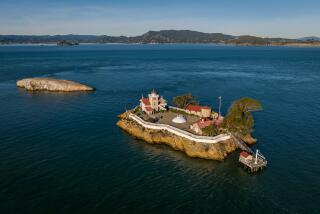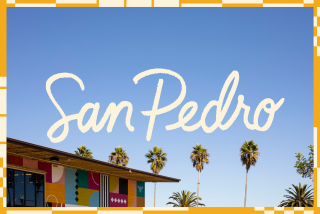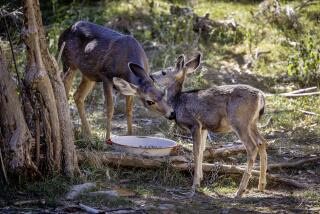Reality Island : Womanâs Gritty Life as Shepherdess on Lonely Santa Cruz Is Told in Book
VENTURA â Michel Petersen has castrated lambs with her teeth, salvaged tons of semiprecious metal by hand and lived without running water for months at a time.
Just as amazing, the tall, plain-spoken Englishwoman has lived in Southern California for nearly 20 years and never--not once--driven a freeway.
âIâm not contributing directly to the pollution of the environment,â said Petersen, who has no driverâs license and relies on others for rides. âItâs a humbling thing. I really know who my friends are.â
Petersen learned to appreciate a life without frills on Santa Cruz Island, where she lived and worked as a shepherdess for five years. Now 43 and a ceramic artist who works in Ventura and Northridge, her experiences with sea-born ranchers and rampaging hunters have been captured in a book, âOnce Upon an Island,â published by the Santa Cruz Island Foundation.
Conditions were poor on the 6,800-acre Scorpion Ranch, a private sheep-farming operation on Santa Cruzâs eastern end where Petersen lived from 1979 to 1984. She left after the landowners sold the property to the National Park Service.
Petersen was hired to cook on a ranch that had no flush toilets. Meals were prepared over a wood stove she named âTin Lizzy.â
After her promotion to head shepherdess, Petersen cared for 5,000 sheep on the primitive island 20 miles off Ventura Countyâs coast. Though up to 15 people lived in the ranchâs wooden bunkhouse at times, she spent many days alone, out on the wind-blown, brush-covered hills.
Except for the elderly mother of the rancher, William âPeteâ Petersen, whom Michel Petersen married in 1983, she was isolated in a âbachelor hive.â
âIt was intimidating and challenging,â said Petersen, a Londoner who was 23 when she arrived on Santa Cruz. âBasically I learned about myself, what I could and couldnât do and what I wouldnât have done because of cultural restraints before.â
Stories of rudimentary farming, chauvinism by the male workers and occasional animal cruelty--a dog is killed for running the flock the wrong way--unfold in the 193-page book. Petersen kept no journal, but decided to write about her experiences after a group of hunters came through and occupied the ranch, killing sheep and pigs. Facing eviction after the sale to the National Park Service, Petersen picked up her pen.
âI had been in solitary confinement for five years and conversations were few and far between, and I can remember most of them,â she said.
Her writing became a form of therapy, especially during the time her husband, 32 years her senior, was recovering from a near-fatal plane crash on the island, a story recounted in Chapter 15.
âI have a very good memory,â she said, âand I was writing under extreme pressure, emotionally and environmentally.â
Petersen comes by her adventuring naturally. She is the daughter of well-known British investigative reporter and novelist Trevor Ravenscroft. Her mother sailed across the Atlantic by herself.
She speaks Spanish, French, German--and âAmerican,â she said. Called Michellino by the ranch hands, Petersen can be bawdy and blunt. She calls things she likes âbrilliant,â and often answers questions with an off-the-record outspokenness.
She ended an interview with an excited âYee-hah!â
After finishing the 35,000-word Santa Cruz manuscript in the fall of 1984, she put it away in a box for 11 years. In 1995 she donated it to the Santa Cruz Island Foundation, a nonprofit group that produces educational materials about the Channel Islands. The foundation has printed 3,000 copies. After 18 months, the rights revert to Petersen, who plans to republish her writing in an expanded form.
Subtitled âA Love Affair With Santa Cruz Island,â Petersenâs historical narrative is the ninth in the foundationâs series of papers about the largest of the five Channel Islands that make up the national park.
âExperiences such as hers will no longer happen,â said Marla Daily, Petersenâs editor and the foundationâs president. âHer time frame represents the end of a particular legacy on Santa Cruz Island.â
With Santa Cruz now controlled by the National Park Service, ranching has ceased, and the Park Service has removed the wild horses, sheep and other nonnative animals from the island.
The animals and ranch operations are documented in nearly 60 photographs taken by Donna Lea, who represented Scorpion Ranch on the mainland.
âShe would always bring a camera, and thank heavens she did,â Petersen said. Now a massage therapist in Ventura, Lea is among those Petersen calls on for rides.
Petersen has returned to Santa Cruz only twice. If offered the chance, she said she would gladly resume her former life on the island--âon my own terms, though.â
Petersen opposes Park Service policies on Santa Cruz. She advocates maintaining a well-controlled herd of horses and a flock of 200 sheep on the island, primarily for the enjoyment of tourists.
âI think itâs a tragedy that all the animals have been taken off,â she said. âThe land seems dead without animals.â
Today, Petersen is artist-in-residence at Ventura Harbor Village. She began training as an artist while on Santa Cruz Island in 1982, with help from an art professor who visited.
âI wanted to capture some of what I felt on the island, and I thought that art would be the way,â Petersen said. âHe said, âSet some bottles up and draw them. Thatâs all I can teach you.â â
When she returned to the mainland, Petersen earned a bachelorâs degree in art education from Cal State Northridge, expecting to teach elementary school students.
In May, she plans to complete her masterâs degree at CSUN, in ceramics as applied to public art. Getting a masterâs degree in fine arts is next, she said.
In her Ventura studio-gallery, scattered with colorful blocks of ceramic, some of her tile murals depict the animals she encountered on Santa Cruz Island.
Last year, Petersen won the American Ceramic Societyâs Beatrice Wood Memorial Award, named for the Ojai artist who died last March at age 105.
She has recently been commissioned to make a large ceramic mural for Cal State Channel Islands depicting island scenes. These days, Petersen commutes between Long Beach, where her now 75-year-old husband lives; Northridge, where she attends school; and her gallery in Ventura.
She does all that traveling without her own automobile.
Being a starving artist can be tough, she said. Nearly all the money she earns through her art goes back into clay and other materials to make more art.
âItâs really rough, actually,â Petersen said. âBut it was rough on Santa Cruz.â
FYI
Michel Petersen will sell and sign copies of her book, âOnce Upon an Island,â from 1 to 3 p.m. Saturday in her studio, Suite 117B at Ventura Harbor Village, off Spinnaker Drive. Copies will soon be available for $15, plus tax, at local bookstores and through the Santa Cruz Island Foundation, 963-4949.
More to Read
Sign up for The Wild
Weâll help you find the best places to hike, bike and run, as well as the perfect silent spots for meditation and yoga.
You may occasionally receive promotional content from the Los Angeles Times.






